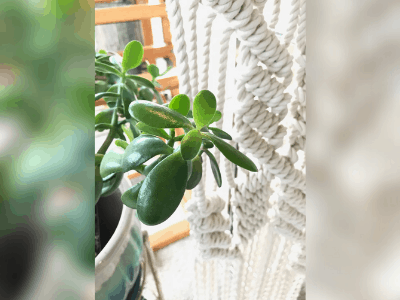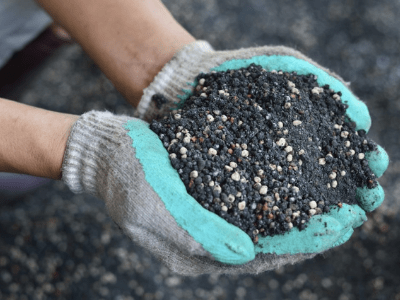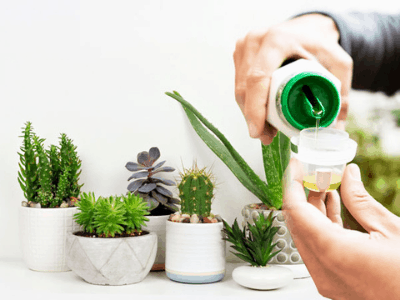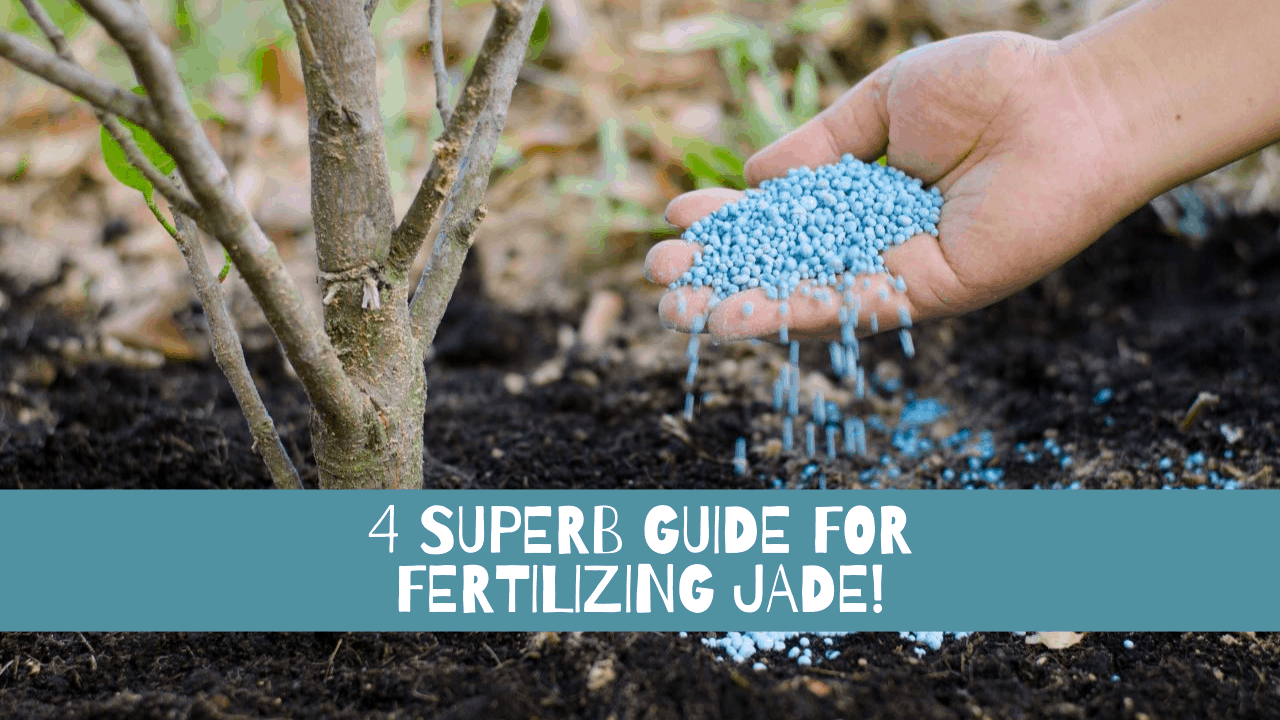Jade plants are rumored to be poisonous to humans and pets, is this true?
That’s not what we’re talking about, but you can find out the answer on our blog.
Go to: Is The Jade Plant Toxic to Humans and Pets? Here’s 4 Facts You Need To Know Before You Have It.
Now let’s talk about fertilizing jade plants
Most homes have a Jade plant (Crassula ovata) as a houseplant.
It features tiny white blooms in clusters and lovely green leaves.
Regular watering and fertilization are required for jade plants as a houseplant,…
…but they need minimal care and fertilizer.
We’ll talk about the different forms of fertilizer for jade plants,…
…how to apply them, when to fertilize jade plants,
…and what are the advantages of fertilizing jade plants on this blog.
A Guide to Fertilizing Jade Plants
The jade plant can bloom beautiful and fragrant white or delicate pink flowers if it is properly maintained.
Because of this, many people choose jade plants as houseplants.
Jades (Crassula argentea) are succulent plants that are deep green in color.
These are native to South Africa.
These are native to South Africa. If you want to know more about Jade, you can click this link.
Throughout Europe and North America, they are grown as houseplants and in containers.
During the daytime, they prefer temperatures between 65 and 75 degrees.
Temperatures in the evening can drop down to 40 degrees.
The result is that they are naturally grown outdoors in USDA climate zones 10 and 11.
Fertilization is essential for growing jade plants.
You can find commercial liquid fertilizers intended for succulents and cacti
..that is a great way to fertilize succulents every 1-2 months.
When your jade plants are actively growing, in the spring and summer,
…dilute it to half strength and apply to them.
Generally, a balanced water-soluble fertilizer will suffice
if you are unable to purchase a commercial succulent fertilizer.
To prevent salt build-up in the soil I flush it with plenty of water…
…every few months to prevent this from occurring.
Let’s hear the story from Dean to know more about fertilizing jade.
Let us hear Dean’s story
Last Sunday was the best day of my life. Finally, my jade is blooming…
After one and a half years, caring for it with patience. I didn’t even know…
That fertilizing jade will have a big impact on the growth of my jade.
I’m so proud of myself.
Keep going…
Whenever jade’s flower is mature, star-shaped flowers in pink or white bloom on this plant.
Fertilizing jade itself is necessary. It needs proper care, including fertilizing jade plant soil.
It is necessary to preserve a healthy life cycle. The jade thrives when it’s watered regularly the fertilizer needs to be…
… lighter in concentration. Plants requiring full sun must receive regular moist well-draining soil.
However, if it’s too much water and fertilizing jade will lead to branches.
The stems are also becoming softer and leggier.
So, what do we do now?

Fertilizing jade plants twice a week was done during active growth periods;
Normally, fertilizing jade doesn’t need more than once every three to four months.
Summer is typically the time of year during which active growth occurs.
Although jades grow slowly, they are still beautiful plants.
The winter months necessitate the use of less water and fertilizer…
…so green jade plants become ready to bloom.
When it comes to fertilizing jade plants, winter is the best time.
The plant will prosper only if it receives optimal filtered sunlight that is bright.
Fertilizer

Fertilizing jade plant also requires knowing what fertilizer to use.
Let’s assume that what we are talking about is looking for information…
…on the fertilizer used for jade plants (Crassula argentea) in pots either kept within the house or outdoors.
Fertilizing potted plants is very important, especially fertilizing Jade so that it remains healthy and thrives.
You may not have understood exactly. Now that you know what fertilizer is, let’s learn more about it.
First thing to understand is that fertilizer is not really plant food. Plants don’t need to be fed the way puppies, for instance, need to be fed.”
Marlie Graves, professional interior horticulturist.
Air, water, and light are the only elements plants rely on to make their own food;
A fertilizer is a mix of minerals that plants need in order to function properly.
It is best to use very small amounts to make the enzymes hormones, proteins, and other substances that allow them…
…to carry on their life processes, such as construction of chlorophyll molecules among hundreds of other things.
All plants absorb mineral salts through their roots.
Minerals such as these occur naturally in the soil, either in the form of soil particles (such as clay)…
…or as the result of the breakdown of organic substances.
In some soils fertilizer is needed when one or more minerals are lacking or the minerals have become depleted…
…over time because the plants have used them.
Go on…
Plants in containers are considered a special category of plants because the roots and soil are constrained…
…and limited by the walls of the pot.
Minerals used by the roots need to be replenished either by adding new soil or by fertilizing.
There are two main types of fertilizers:
Organic and chemical. Chemical fertilizers,
…such as fish meal and compost are produced by mining and recycled compounds.
Organic fertilizers are derived from animal or plant waste products.
On the label of every commercially packaged fertilizer product, one finds the formulation…
…in the form of numbers such as 20–20–20 or 3–1–2.
A nutrition label may indicate the relative proportions of the macro-elements, nitrogen, phosphorus, and potassium…
…which are the minerals essential for plants.
The label may also indicate some “micro-elements,” other minerals that are essential.
Chemical or organic fertilizer minerals have to be absorbable in the form of mineral salts.
In order to be absorbed by the roots.
Organic fertilizer is converted to mineral salts by the chemical activity of the soil and the microbes that occupy it…
…and as a result, it is usually not as strong as chemical fertilizers though they remain available to plants longer.
Kind of Fertilizer

We advise mixing a liquid or granular fertilizer with water that is specially…
…formulated for plant pots either indoors or outdoors.
There are chemical and organic fertilizers available, but I avoid the “sticks” and things like that.
If your plants are outside in lots of light, you can use granular fertilizer…
…that dissolves slowly on the soil surface, but I have found liquid fertilizer to work best.
Here’s the interesting part…
There are many formulations for various species of plants for example flowering plants, tomatoes, etc.
However, all plants utilize macro-elements exactly the same way which is 3–1–2 so you only really need a fertilizer…
…formula that is somewhere around that ratio such as 9–3–6, 10–4–8, or even 30–10–20.
In the absence of anything a fertilizer with equal numbers like 10–10–10, is acceptable.
You should also try to find products that are enriched with sulfur, magnesium, molybdenum, zinc, and copper.
There are also liquid fertilizers, water-soluble fertilizers and controlled-release fertilizers.
There are also organic products, including fish emulsion, blood meal, and bone meal.
Any of these can be applied to jade plants if you follow the product instructions carefully..
..and determine the correct way to apply it.
It is best to use a balanced fertilizer such as 10-10-10.
Some growers prefer fertilizers with higher phosphorus and potassium levels and lower nitrogen levels..
.in these cases, higher numbers in the last two numbers of the formula are needed.
A typical example would be 7-15-12, which represents the percentage weights of nitrogen, phosphorus and potassium.
How Much and How Often?

When mixing fertilizer with water is important…
…to dilute chemical fertilizer by just half the amount advised on the label.
When using a formulation with a higher number 1/4 strength is probably ideal.
You just mix up your fertilizer solution and use that to water your plants when you fertilize jade.
Interesting right?
Most houseplants, including your jade plant,
..do not need to be fertilized more than three or four times a year.
Plants in very high light, like in front of a south-facing window,
…however, will need fertilizer on a regular basis.
During spring and summer, herbaceous plants and plants in bloom could be fertilized monthly.
Lower light plants don’t need to be fertilized regularly.
Most people underestimate how much fertilizer houseplants require.
Problems arise when too much fertilizer is put in pots that the roots cannot absorb.
Over time, the unused fertilizer in the form of mineral salts should be added to the soil so that the salt gets to a point…
…where it causes problems for the plant.
Next…
During periods of active growth increase the fertilization of your jade plant to once every two weeks.
However, to prevent overfeeding, use the fertilizer at half the recommended rate.
To do this, mix half fertilizer with half water.
When provided with sufficient light most fertilizing jade, the process stops altogether in November…
…through March to prevent soft leggy stems. Repot it four months after fertilizing jade.
The general rule for all plants including jade plants is to avoid fertilizer when the plant is not growing.
For a jade plant, this is about November to March. The plant is not in nutrient-uptake mode then…
…so fertilizer remains in the soil and can build up to levels that can kill roots.
Wait until you see signs of new growth, such as leaf buds appearing on branch tips.
Jade plants usually flower during spring and summer so fertilize them during that time.
If you are fortunate enough to have a jade plant that blooms during winter fertilize it prior to flowering.
Maintenance
During periods of active growth increase the fertilization of your jade plant to once every two weeks.
However, to prevent overfeeding use the fertilizer at half the recommended rate.
To do this, mix half fertilizer with half water.
When provided with sufficient light most fertilizing jade process stops altogether in November…
….through March to prevent soft leggy stems.
When your jade plant is re-potted, wait four months before fertilizing jade.
Let the soil dry out between waterings…
…and keep the plant out of intense direct sunlight until it is well established.
How to Care for Jade Plants Jade plants need at least 4 hours of direct sunlight each day.
Young plants should be kept in bright, indirect sunlight; large, well-established jade plants…
….can handle more direct sunlight.
As well to the above process, it is also necessary to take care of jade plants when watering them.
Watering a jade plant with coffee grounds is a good example.
Is it possible? You may be wondering. Are coffee grounds safe for jade plants?
You can find the answer on our blog, you will definitely be surprised.
Let’s move on to another care…
Jade Care
With its stout trunk and branches bearing rounded, glossy, green succulent leaves, often rimmed in red..
..the jade plant (Crassula ovata, also called C. argentea) is a fascinating sight.
A jade plant can be grown to specimen stature by following a few basic guidelines..
..and keeping an eye out for signs of developing problems.
The most common mistake is to overwater and overfertilize jade plants..
..which often proves fatal rather than beneficial.
A jade requires regular watering and light fertilization..
This sun-loving plant requires good soil drainage and moist conditions..
However, too much water and fertilizer can cause branches and stems to become soft and leggy..
You only have to fertilize jade plants every three to four months if they are inactive growth.
Fertilizing jade every two weeks during dormancy.
Growing is most active during the summer months…
…although jade is a slow-growing indoor plant. The winter months are especially good for jades…
…as they require less water and fertilizer, prior to flowering.
Jade thrives in zones 9 to 11 and can be grown successfully in colder zones
Jade plants grow best at room temperature (65° to 75°F / 18° to 24°C)…
…but prefer slightly cooler temperatures at night and in the winter (down to 55°F / 13°C).
if grown indoors or brought indoors during Winter.
Fertilize your jade plant solely if it receives insufficient..
..bright filtered sunlight during the winter.
The lovely plant, with its fleshy and oval-shaped leaves…
…can live for years, even decades if well taken care of.
At the garden center, you’ll usually find several types of jade plants..
..including the Common Jade (Crassula ovata),
Silver Jade (my favorite, shown below) and Variegated Jade…
…(green leaves with streaks of creamy white).
Make sure the base of the plant sits on top of the soil…
…and parallel to the top of the pot, you do not want the leaves touching the soil!
When you submerge it you will see shriveled-up leaves that slowly wither away.
If the soil feels dry grab a watering can and slowly pour water on the soil, not the leaves.
The roots need water, the leaves do not! The leaves will be less vibrant and the growth will be slower…
…..in plants grown in less than four to six hours of sunlight.
Jade plants grow best in full sun and grow lush, green leaves that produce several branches..
..this is why they flourish outdoors in spring and summer.
Keep reading…
What Fertilizer Does Your Jade Need?
Soil Mixture
Plants can survive three to four months without fertilization..
…with the right potting soil mixture as long as it contains nutrients and minerals.
Specially formulated soils for cacti and succulents are among these mixtures.
Use sphagnum peat moss, coarse perlite, and coarse sand as the base for your soil..
..will result in rich organic matter for your jade plant.
It is important to choose soil that drains well.
Excessive moisture may promote fungal diseases such as root rot.
Root rot is caused by too much moisture in the soil.
The jade plant needs proper soil mixtures to store nutrients and minerals between fertilization.
These soil mixtures are specifically designed for succulents.
If you prefer, you can also make your own mix by mixing coarse perlite with sphagnum peat moss.
I personally think that soil mixture affects the plant’s growth a lot.
I’ve been using this soil mix for a long time. I used to have root rots problems and now it has been a good media for my succulents to grow
Liquid Fertilizers
The easiest way to fertilize your jade plant is with a liquid fertilizer..
Use a formula specifically for cacti and succulents..
Water is not only important for the application of liquid fertilizers..
..but also for proper absorption.
Ensure your jade plant is properly hydrated before and after fertilizing.
The root system of the plant can be damaged..
..if a liquid fertilizer is applied to the soil when the soil is dry.
It is easy and quick to apply liquid fertilizer to your jade plant.
Choose a fertilizer that is designed for succulents.
Liquid fertilizers require water,
so be sure to water your plants before and after applying the liquid fertilizer..
..and never apply the fertilizer if the soil is dry.
Nitrogen Needs
Jade plants that drop their leaves can mean one of two things…
..either the plant isn’t getting enough light…
..or it needs more nitrogen. Use a high-nitrogen plant food…
..such as a 10-20-10 formula.
Jade plants thrive when fertilized with plant foods intended for African violets.
Also,
fish emulsion is an organic fertilizer that can provide enough nitrogen
to give jades a vibrant appearance.
If your jade plant’s leaves are drooping…
it could mean that your plant isn’t getting enough sunlight or it lacks nitrogen.
It may be necessary to use plant food with high nitrogen content.
Use the formula 10-20-10, and this will ensure the right amount of nitrogen for your plants.
Rates
Increase the frequency of fertilization to every two weeks when your jade plant is active.
It is recommended however to use half the recommended amount of fertilizer and dilute it with half water and half fertilizer.
This is to ensure that you don’t overfeed your plants. Typically active growth occurs during the summer months…
…and varies from plant to plant. Jade plant owners who have access to proper light…
…often stop fertilization altogether between November and March to prevent soft, leggy stems.
Do not fertilize your jade plant for at least four months after re-potting.
When Is the Best Time to Fertilize Jade Plants
Jade plants do not require much fertilizer.
You can fertilize jade plants every two weeks when they are actively growing;
Fertilizing jade plants every three to four months is the option.
Jade plants grow slowly and therefore do not require much fertilizer.
Most of their active growth occurs in the summer, and you only need to fertilize them…
…during the winter if the plant does not receive adequate sunlight.
I have so many jade plants myself. My jade plant has grown faster and looks healthy after I applied the fertilizer twice a week!
Last but not least
Fertilizers That Cause Harm To Jade Plant
- Jade plants are sensitive to the salt in tap water, so make sure you use distilled water when watering them.
- While watering the leaves, avoid splashing the water on them, as this will expose them to a humid environment.
- When fertilizing jade plants, use a fertilizer made especially for cacti or houseplants.
The Benefits of Fertilizing Jade Plants
Jade plants are lovely plants that can beautify any area with their elegance.
They, like all plants, need frequent care to stay healthy and attractive.
Fertilizers come in a variety of forms, so experiment until you find one that works for your jade plant.
By fertilizing jade plants, you will ensure they thrive and make maintenance easier for you.
It’s important to fertilize your jade plant on a regular basis, especially if you have a big jade plant.
Sum up
Jade is a succulent plant. That have easy to take care of in the other fertilizing jade is quite troublesome.
If you don’t watch it carefully. The bad composition of fertilizer can cause death to the plant.
Even it seems so easy. Fertilizing jade plants was one of the obstacles that you need to accomplish.
A good rule of thumb for any plant, including jade plants, is to avoid giving fertilizer when the plant is not growing.
Plant your jade plant in a succulent mix that drains well…
…provide a mix of direct and indirect light, and water thoroughly once the potting mix is nearly dry.
Fertilize every two months during the growing season at temperatures of 65-86°F (18-30°C).
Plants whose leaves are variegated do well in low light, especially if you have bright indirect light.
Even though the standard Crassula ovata jade plant is the most common.
..there are many other interesting varieties available.
Conclusion
When it comes to plants, the jade plant is a good choice whether you’re an experienced gardener or just a beginner.
Since it resembles a tree, it looks amazing in your house as a decorator, especially during festive times.
This plant is also called a ‘money plant,’ since many people believe it is a sign of wealth and wealth. It is often given as a gift since it lives so long!
Your jade plant can thrive if you provide it with proper care, and it could even grow into a jade tree!
Even jade doesn’t need extra care other than any other plant.
It needs to be reminded that fertilizing jade is needed.
Fertilizing jade plants is an important step. You may assist your jade plant to reach its full potential…
…by applying the proper fertilizer at the appropriate time.
Also, make sure to water your Jade plant adequately to achieve the greatest effects,…
…in addition to fertilizing jade. For you, if you want to have good and beautiful jade.
Do you have a question about fertilizing jade that you read?
Or do you have any recommendation method for fertilizing jade?
Either way, go ahead and leave a comment below right now! See you next time!
Frequently Asked Questions
What types of fertilizers should I use on a jade plant?
According to the needs of the plant, fertilizers should be diluted.
Use half the recommended quantity as a general rule of thumb.
Nitrogen, phosphorus, potassium, and calcium are some of the best fertilizers for jade plants.
Can I use any other type of fertilizer on jade pot plants?
Jade plant fertilizers should not be used. Potassium and phosphorus levels…
…in some fertilizers are too high for jade plants, which is why they should be avoided.
Is it okay to apply compost to my jade plant?
No, jade plants shouldn’t be fertilized with compost since it might include substantial quantities of nitrogen.
Compost applied to a jade plant in combination with other organic fertilizers is the best way to do it.
How can I tell if my Jade Plant is getting sick?
Yellowing leaves, wilting plants, and reduced growth are all symptoms of jade plant illness.
Make sure to contact a plant expert if any of these symptoms appear.
How often should I fertilize my jade plant?
This is a question that has no one definitive answer, depending on the plant’s specific requirements.
Some plants, such as jade plants, may need fertilization more often than others.
However, jade plants are usually fertilized every two to three months.
What are the possible side effects of fertilizing jade plants?
Jade plant disease, jade plant rot, and jade plant browning may be caused by fertilizing jade plants.
Certain fertilizers, if applied too soon, may cause plants to develop excessively quickly and might produce diseased branches.
Over-fertilization and damage may also occur if jade plants are fertilized excessively.
Always use the fertilizer that comes with the instructions.
How do I know if my jade plant is getting enough water and nutrients?
Checking the soil every week and fertilizing as needed is always recommended for jade plants since they need a balanced mix of nutrients.
Can fertilizer solution be applied directly to the soil or should plants be watered thoroughly?
Since it gets water to plant roots faster and promotes plant health, watering plants thoroughly…
…is usually a good idea. Fertilizing plants with a concentrated dose of fertilizer…
…on the soil surface may help them obtain higher agricultural yields,…
…although this technique is less effective at supplying water to plant roots.


















